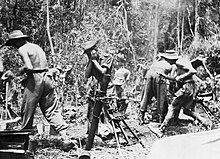User:Mosedschurte/PaulAlliedM01
Allies gain momentum
Following the Guadalcanal Campaign, in May 1943, American forces began eliminating Japanese forces from the Aleutians,[1] followed by major operations to isolate Rabaul by capturing surrounding islands and to breach the Japanese Central Pacific perimeter at the Gilbert and Marshall Islands.[2] By March 1944, the Allies had completed both of these objectives, and additionally neutralized another major Japanese base in the Caroline Islands. In April, the Allies launched an operation to retake Western New Guinea.[3]
On July 4, 1943, Germany attacked Soviet forces in the region of the Kursk Bulge. Within a week, German forces had exhausted themselves against the Soviets' layered defenses and large reserve forces[4] and Hitler canceled the operation.[5] This decision was partially affected by the Western Allies' invasion of Sicily launched on July 9 which, combined with with previous Italian failures, resulted in the ousting and arrest of Mussolini later that month.[6] A Soviet counter-offensive pushed Axis troops to the hastily fortified Panther-Wotan line along the Dnieper river, which was later broken at Smolensk and by the Lower Dnieper Offensives.[7] By June 1944, the Soviets had largely expelled Axis forces from the Soviet Union and made incursions into Romania.[8]
In early September 1943, the Western Allies invaded the Italian mainland, following an Italian armistice with the Allies.[9] Germany responded by disarming Italian forces, seizing military control of Italian areas,[10] and creating a series of defensive lines.[11] German special forces then rescued Mussolini, who then soon established a new client state in German occupied Italy.[12] The Western Allies fought through several lines until reaching the main German defensive line in mid-November.[13]
By May 1943, as Allied counter-measures became increasingly effective, the resulting sizable German submarine losses forced a temporary halt of the German Atlantic naval campaign .[14] In November 1943, Franklin D. Roosevelt and Winston Churchill met with Chiang Kai-shek in Cairo[15] and then with Joseph Stalin in Tehran.[16] The former conference determined the post-war return of Japanese territory[15] while the latter included agreement that the Western Allies would invade Europe in 1944 and that the Soviet Union would declare war on Japan within three months of Germany's defeat.[16]
In January 1944, the Allies launched a series of attacks in Italy against the line at Monte Cassino and attempted to outflank it with landings at Anzio.[17] Soviet forces expelled German forces from the Leningrad region[18], ending the longest and most lethal siege in history. The German Army Group North and Estonians hoping to re-establish national independence halted the following Soviet offensive at the pre-war Estonian border, retarding subsequent Soviet Baltic Sea region operations.[19]
By late May 1944, Allied Italian offensives succeeded while several German divisions retreated. On June 4 Rome was captured.[20]

In March 1944, the Japanese launched the first of two invasions, an operation against British positions in Assam, India[21], which soon led to Japanese forces besieging Commonwealth positions at Imphal and Kohima.[22] By May, Chinese forces that had invaded Northern Burma in late 1943 then beseiged Japanese forces in Myitkyina.[23] The second Japanses invasion attempted to destroy China's main fighting forces, secure railways between Japanese-held territory and capture Allied airfields.[24] By June, the Japanese had conquered the province of Henan and begun a renewed attack against Changsha in the Hunan province.[25]
- ^ Thompson, John Herd; Randall, Stephen J. Canada and the United States: Ambivalent Allies, p. 164.
- ^ Freedom from Fear: The American People in Depression and War, 1929–1945, p. 610.
- ^ Rottman, Gordon L. World War II Pacific Island Guide: A Geo-Military Study, p. 228.
- ^ Soviet military deception in the Second World War by David M. Glantz; Routledge, 1989ISBN071463347X, 9780714633473, 644 pages, pp. 149–59
- ^ Kershaw, Ian. Hitler, 1936–1945: Nemesis, W. W. Norton & Company, 2001, ISBN 0393322521,p. 592.
- ^ O'Reilly, Charles T. Forgotten Battles: Italy's War of Liberation, 1943–1945, p. 32.
- ^ Glantz 2001
- ^ Chubarov, Alexander. Russia's Bitter Path to Modernity: A History of the Soviet and Post-Soviet Eras, p. 122.
- ^ McGowen, Tom. Assault From The Sea: Amphibious Invasions in the Twentieth Century, Twenty-First Century Books, 2002, ISBN 0761318119, pp. 43–44.
- ^ Lamb, Richard. War in Italy, 1943–1945: A Brutal Story, pp. 154–55.
- ^ Hart, Stephen; Hart, Russell. The German Soldier in World War II, p. 151.
- ^ Blinkhorn, Martin. Mussolini and Fascist Italy, p. 52.
- ^ Read, Anthony; Fisher, David. The Fall of Berlin, p. 129.
- ^ Read, Anthony. The Devil's Disciples: Hitler's Inner Circle, p. 804.
- ^ a b Iriye,, Akira, Power and culture: the Japanese-American war, 1941-1945,Harvard University Press, 1981, ISBN 0674695828, page 154
- ^ a b Polley, Martin, A-Z of modern Europe since 1789, Taylor & Francis, 2000, ISBN 041518598X, page 148
- ^ Weinberg 1995, p. 660-661
- ^ Glantz, David M., The siege of Leningrad, 1941-1944: 900 days of terror, Zenith Imprint, 2001, ISBN 0760309418, pages 166-69
- ^ David M. Glantz (2002). The Battle for Leningrad: 1941–1944. Lawrence: University Press of Kansas.
- ^ Havighurst, Alfred F. Britain in Transition: The Twentieth Century, p. 344.
- ^ Lightbody, Bradley. The Second World War: Ambitions to Nemesis, p. 224.
- ^ Zeiler, Thomas W. Unconditional Defeat: Japan, America, and the End of World War II, p. 60.
- ^ Craven, Wesley Frank; Cate, James Lea. The Army Air Forces in World War II, Volume Five — The Pacific, Matterhorn to Nagasaki, p. 207.
- ^ Hsiung, James Chieh; Levine, Steven I. China's Bitter Victory: The War with Japan, 1937–1945, p. 163.
- ^ Coble, Parks M. Chinese Capitalists in Japan's New Order: The Occupied Lower Yangzi, 1937–1945, p. 85.
